U4-Reading
Unit4Reading基础练习牛津译林版七年级英语下册

U4 Reading 基础练习一、根据句意、汉语、首字母提示或英文释义写出单词。
1.Please r__________to take everything. Maybe we will need them later.2. There is a small__________(桥)over the river.3.Just go__________(径直地)along the road and you'll see the bookshop on your left.4. Look! The old man is__________(穿过)the road.5. There is no__________(路)in the front. We have to go down here.6. Wang Baoqiang is a__________(滑稽的)actor(演员).He often makes people laugh.7. A lion is often called the__________(国王)of the jungle(丛林之王). It is good at hunting small animals.8.It's__________(危险的)for you to play football in the street.9. Monkeys are__________(very) cute animals. They always make us laugh.10.-Why do pandas like eating__________?-I don't know. You can ask our teacher.二、用方框中所给单词或短语的适当形式填空。
be ; not play; sound; drink; go around; learn1. The baby looks cute and likes________________milk.2. There are different________________in the forest.3. We all know that the moon________________the Earth.4.My English is poor. I'll try________________it well.5. Mr White asks us________________football on the road.6. Mr White asks us________________football on the road.7.There________________a new school in my hometown in three months.三、单项选择。
八上英语U4 Reading教案
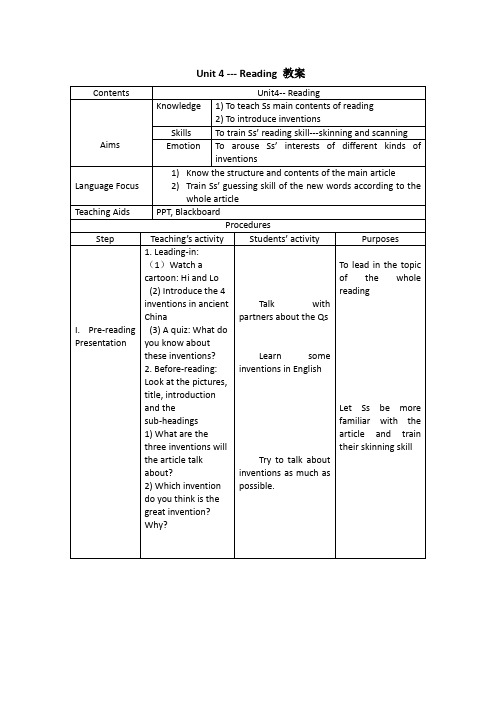
Learn some new language points
Be more familiar with the whole passage
Learn the new words and phases
IV. Homework
1)学案Reading一张
2)英语周报一张
1)What are the three inventions will the article talk about?
2)Which invention do you think is the great invention? Why?
Talk with partners about the Qs
Learn some inventions in English
Try to talk about inventions as much as possible.
To lead in the topic of the whole reading
Let Ss be more familiar with the article and train their skinning skill
Unit 4 --- Reading教案
Contents
Unit4-- Reading
Aims
Knowledge
1) To teach Ssmain contents of reading
2) Tointroduce inventions
Skills
To train Ss’readingskill---skinning and scanning
II. While-readingProcedure
U4reading

pictures.
It’s hot and humid.
There are a lot of model dinosaurs.
You can hear very loud noise.
Something may chase you.
Cars may shake violently.
The special effects are great!
Roddy was impressed by the Great Wave attraction. How did he describe it?
thing
how
the Great Wave attraction everything wave
awesome peaceful huge
noise the car shook
E1 Read the introduction and the first paragraph of the newspaper article on page 55. Complete the table below.
Philip
Youth Post
Julia Carter
Roddy Wang
• camera operator • lighting operator • sound operator • film set • film director • make-up artist • extras • crew • spectators
spectators
film director camera operator lighting operator
It was a piece of cake!
terrific violently
译林版8年级英语上册教案课件-第4课-U4Reading
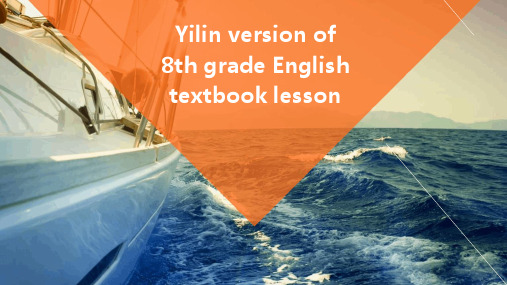
知识掌握程度
通过考试或测验评估学生对课程知识的掌握程度。
综合应用能力
评估学生在实际情境中运用所学知识的能力,如口语表达、写作能力等。
谢谢聆听
Details
Summary: This stage focuses on explaining and practicing vocabulary and phrases that are important for comprehension and communication. Activities will include defining words, creating sentences, and engaging in discussions using the target language.
Teaching content
文本内容分析
总结文章主题和主要内容
分析文章结构和段落关系
探讨作者的观点和意图
引导学生理解文章深层含义
词汇和表达
重点讲解生词和短语
解释词汇在上下文中的含义和用法
给出例句,帮助学生理解词汇的实际应用
引导学生归纳和总结词汇的用法和规律
强调英语语言的特点和规律
分析文章中的语法结构,如句子结构、时态、语态等
Summary
The teacher will begin by asking students about their understanding of the topic and what they already know. This can be done through a series of open questions to stimulate discussion and activate prior knowledge. The teacher will then introduce the objectives of the lesson and explain how it fits into the larger scheme of things.
U4 Reading
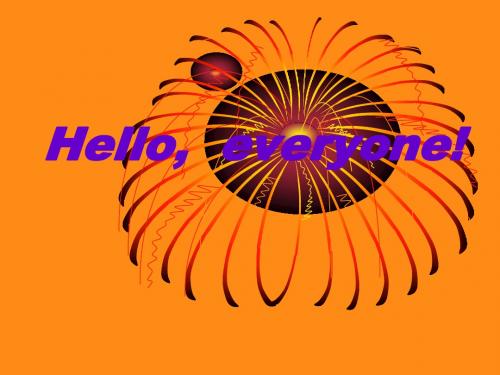
Story 3 Why does Simon hate the braces? 1) His friends all laugh at him and say bad things about him; 2) He feels embarrassed when he smiles or opens his mouth; 3) The braces hurt his teeth and it’s difficult for him to eat.
Make
a
summary
What have you learned in this class?
D1 Read the Internet posts on page 51.
Which person does each sentence describe? Write in the blanks. (P 53) 1. She often plays the piano when her elder sister is studying. Julie’s seven-year-old sister. 2. She made Simon wear braces. Simon’s mother. 3. She has many photos of thin models. Anna’s friend Jolin.
Unit
4
Problems and advice
Reading
Learning aims
Read to learn the problems of four teenagers. Can answer the questions by reading the stories.
译林牛津版高中英语选修9课件:U4 Reading(优秀PPT)
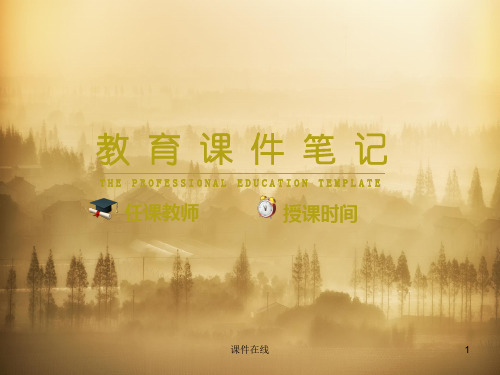
1. What is an idiom?
An idiom is a group of words or an
expression whose meaning is not
straightforward, because it often cannot
be understood by looking at the meanings
➢ To learn how to understand analogies
➢ To master the new words and idioms in this article
课件在线
8
straightforward honest about your feelings or opinions;
B: I got beaten by Peter’s brother.
A: That’s a bad apple! Let’s think up a way and teach him a lesson.
a bad apple: 坏蛋
课件在线
3
2. A: Give the skates to me!
B: You shut up! A: If you don’t know how to skate, why
don’t you give the skates to me? Don’t be a dog in the manger.
a dog in the manger: 占着茅坑不拉屎
课件在线
4
3. A: There’s no point in losing temper on me. It’s unfair!
of its separate words.
牛津深圳版七年级上册英语U4 Reading-最新

Look at the pictures and the sub-headings of the article on page 45. Then answer the questions below.
Spring
The four seasons
Summer
Autumn
a. spring b. summer c. autumn d. winter
1.
2.
d
c
3.
4.
a
b
Unit 4 Reading
Picture 1: We can see footprints in the snow. Picture 2: The trees are brown and the girl is
The puddles get.
All over town.
pwuedtdle
kicdkry
Unit 4 Reading
Read the poem and find out the rhyme of each verse.
In winter, Watch us go, Making footprints In the snow.
spring summer autumn winter
In the snow.
Made by me.
In (2)___sp__ri_n_g______ In (4)__a_u_tu_m__n_____
My shoes are wet. Trees are brown.
See how deep
I kick the leaves
In autumn, Trees are brown. I kick the leaves All over town.
广州版英语八年级第一学期课堂笔记U4 Reading
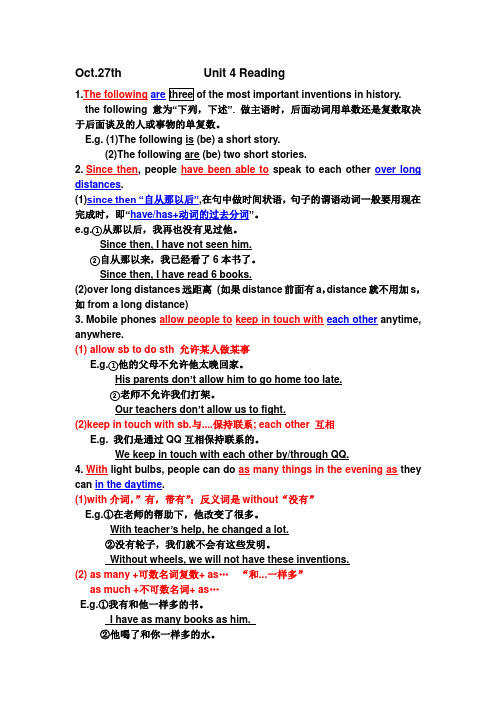
Oct.27th Unit 4 Reading1.The following are three of the most important inventions in history.the following 意为“下列,下述”. 做主语时,后面动词用单数还是复数取决于后面谈及的人或事物的单复数。
E.g. (1)The following is (be) a short story.(2)The following are (be) two short stories.2. Since then, people have been able to speak to each other over long distances.(1)since then “自从那以后”,在句中做时间状语,句子的谓语动词一般要用现在完成时,即“have/has+动词的过去分词”。
e.g.①从那以后,我再也没有见过他。
Since then, I have not seen him.②自从那以来,我已经看了6本书了。
Since then, I have read 6 books.(2)over long distances远距离(如果distance前面有a,distance就不用加s,如from a long distance)3. Mobile phones allow people to keep in touch with each other anytime, anywhere.(1) allow sb to do sth 允许某人做某事E.g.①他的父母不允许他太晚回家。
His parents don’t allow him to go home too late.②老师不允许我们打架。
Our teachers don’t allow us to fight.(2)keep in touch with sb.与....保持联系; each other 互相E.g. 我们是通过QQ互相保持联系的。
高中英语课件-B1U4- Reading
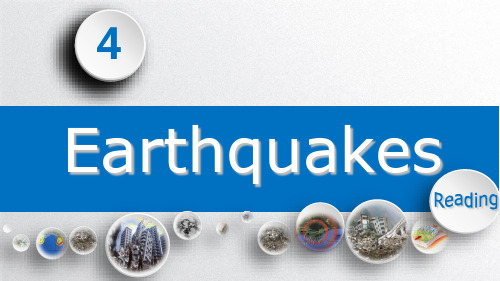
On the ground
In the sky bright lights , the sound…
Para. 2-3 Data (数据)
❖ _1__/3__ of the nation felt the earthquake. ❖ A huge crack that was _8_ kilometres long and
为纪念唐山抗震救灾四十周年,某英文报发起以 “Great Changes”为题,描述灾区新貌的征文活动, 写一篇英语短文应征。
1. 灾后唐山及人民生活的变化; 2. 发生变化的原因; 3. 你的感想及祝愿。 注意: 1. 可根据提示适当发挥
2. 词数:120左右
Hello, everyone! We are group …
IFW niroshtulyra,ot…pcinainont, hase…y do?
What’s more, … At last, …
Businessmen
The look
Homework
What help did the country give to Tangshan after the earthquakes ?
Post-reading
What can they do to help the people in Tangshan?
Workers Doctors
Governmen t
para(s) ___1___ para(s) __2__3__ para(s) ___4___
Careful reading
Read Para.1 and fill in the form.
Where
What happened
Underground water,well walls,smelly gas…
必修四U4Reading-communication-no-problem-课件
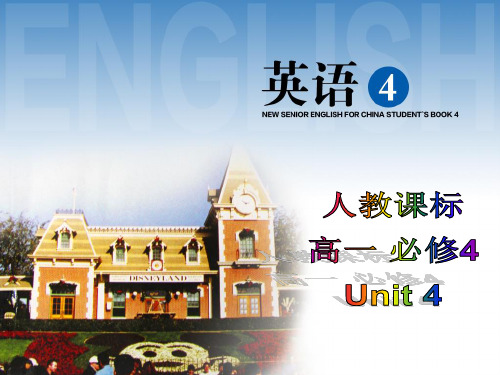
For example, if I’m angry, I might turn away and not talk to others. If I’m happy to see someone, I might smile and hold out my hand or open my arms.
3. Who seemed to prefer to keep more physical distance from others? Who seemed to prefer closer physical distance? The British woman, Julia, and probably the Canadian man, George, seemed to prefer to keep more physical distance from others. The Colombian man, Tony, and the Jordanian man, Ahmed, seemed to prefer closer physical distance.
Part 2 (Para. 2 and 3) People from different countries express greetings in different ways.
Part 3. (Para. 4) Different peoples have different body languages.
to women
Darlene woman Coulon from
France
shake hands people she and kiss twice knows on each cheek
Country/ Ways to greet each other
七年级上册英语U4 Reading知识点
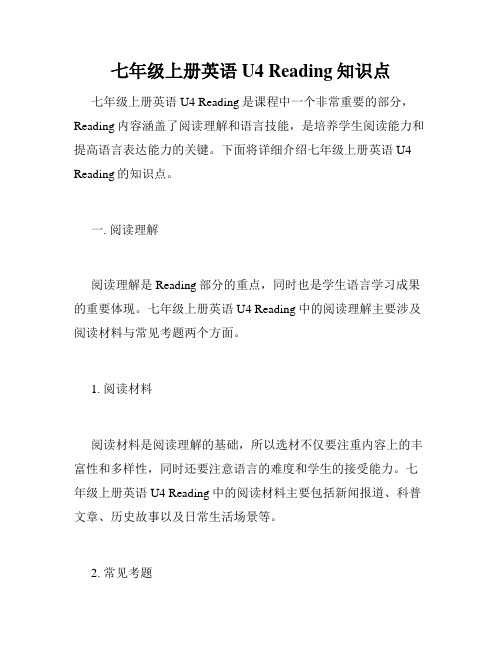
七年级上册英语U4 Reading知识点七年级上册英语U4 Reading是课程中一个非常重要的部分,Reading内容涵盖了阅读理解和语言技能,是培养学生阅读能力和提高语言表达能力的关键。
下面将详细介绍七年级上册英语U4 Reading的知识点。
一. 阅读理解阅读理解是Reading部分的重点,同时也是学生语言学习成果的重要体现。
七年级上册英语U4 Reading中的阅读理解主要涉及阅读材料与常见考题两个方面。
1. 阅读材料阅读材料是阅读理解的基础,所以选材不仅要注重内容上的丰富性和多样性,同时还要注意语言的难度和学生的接受能力。
七年级上册英语U4 Reading中的阅读材料主要包括新闻报道、科普文章、历史故事以及日常生活场景等。
2. 常见考题常见考题是七年级上册英语U4 Reading中的关键考察点,其中包括选择题、判断题、填空题以及解答题等。
选择题是考察学生阅读理解和语法知识的重要手段,判断题则往往需要学生针对文中某一信息进行正确判断,填空题需要学生准确地掌握文章中的关键词语和句子表达,解答题则需要学生具有较强的语言表述和总结归纳能力。
二. 语言技能语言技能是Reading部分的另一个重点,其中包括词汇、语法和语言表达能力等。
1. 词汇七年级上册英语U4 Reading中的词汇以生活常用词汇和基础词汇为主,学生需要掌握这些词汇的正确拼写和用法,并能够在阅读中准确理解其中的含义。
2. 语法语法是英语学习的基础,七年级上册英语U4 Reading中的语法主要涵盖时态、语态、代词、介词、连词等基本语法知识。
3. 语言表达能力语言表达是Reading中最终的目的,因此学生不仅需要掌握相关的语法和词汇知识,更需要在实践中不断提升自己的语言表达能力。
这其中包括语音、语调、流畅度、准确度、适当的语境运用等。
总体来说,七年级上册英语U4 Reading的知识点非常丰富,需要学生在课堂上认真听讲,掌握必要的课外知识,不断训练阅读理解和语言表达能力,提高英语学习的目的达成度。
新译林八年级上U4-Reading课件
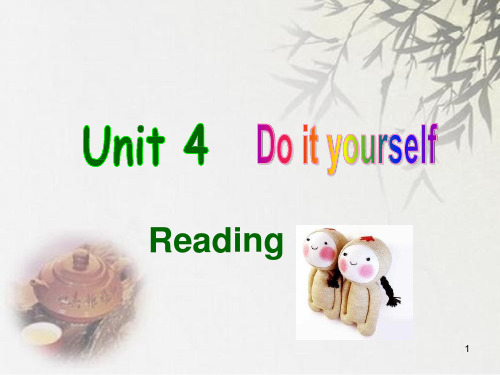
Sample conversation
A: Do you like to do DIY in your spare
time?
B: Of course. I’m a member of the school
DIY club. I can do lots of things on my
own and I often help my mum with the
2
Words & phrases review
power cut pipe fill
fill … with … not only … but (also) ceiling
n. 供电中断;停电 n. 管子,水管 vt. 使充满 用……填充…… 不仅……而且……; ……和…….都 n. 天花板
3
shelf
whoops advise course
already instead attend
Words review
n. (pl. shelves) (橱柜或书 架等的)架子,搁板
excl. 哎呀 vt. & vi. 建议,忠告,劝告 n. 课程;过程 adv. 已经 adv. 反而;却 vt. & vi. 经常去;出席
than the other .
Suzy bought some books about DIY for
Andrew and alsoadvised him to take a course
in DIY. But this made him angry. He says he
knows everything about it. So instead, Suzy is
5. fill…with… 6. not only…but (also)… 7. advise him to do… 8. attend lessons 9. take a course in… Patterns: 1. Stop it.
- 1、下载文档前请自行甄别文档内容的完整性,平台不提供额外的编辑、内容补充、找答案等附加服务。
- 2、"仅部分预览"的文档,不可在线预览部分如存在完整性等问题,可反馈申请退款(可完整预览的文档不适用该条件!)。
- 3、如文档侵犯您的权益,请联系客服反馈,我们会尽快为您处理(人工客服工作时间:9:00-18:30)。
4 in a flash a in a long time b in a short time 5 lifetime a time that somebody works b time that somebody lives 6 like lightning a very quickly b very slowly
A very powerful machine for doing
The ____________. A ____________.
A ____________.
calculations.
B
Read the passage.
How many languages do you know? Everyone knows at least two—his or her own language and the international language of numbers.
A3 Match the words in Column A with the meanings in Column B. A 1 2 3 4 5 6 7 a system developed to calculate powerful amazing to solve lightning a b c d e f g B make … bigger, better and stronger very surprising a group of things that work together to use numbers to find answers strong very bright light in the sky to find an answer to
B Now, look at the title, the introduction, the headings and the pictures. Then on the list below, tick () the things you think the article may tell you. 1 Long ago, there were different ways of writing numbers. 2 Zero is not a number. 3 Zero is an especially important number.
system invent develop invention
lifetime living human following
solve (like) lightning program above
A2 Choose the right meanings for these words.
1 nearly a most b almost 2 invented a did not like b made for the first time 3 accurate a correct b easy
A1 Read the whole passage on page 57 for the first time. Find the following words or phrases in the passage. Work out their meanings by yourself. nearly accurate electronic powerful in a flash calculation whole amazing
One of the first calculating machines was an abacus. Abacuses are so fast and accurate that people still use them today. A modern electronic calculator can add, subtract, multiply and divide. It can also calculate percentages and square roots. Computers are very powerful calculating machines. In a flash, a computer can do a calculation that you could not do in your whole lifetime.
A2 Do you know what ‘language’ means?
Do you know any international languages?
A3 The word digit has two meanings, a number (1, 2, 3, etc.) and a finger. The words calculator and calculate came from a word that meant a stone. Guess the connections between number and finger and between stone and calculator.
Can you calculate how much the holiday will cost?
A4 Can you give the largest number that exists?
A5 Think of the jobs that use numbers a lot and the jobs that do not use numbers often.
5 Do you think that animals can count?
In these two pictures, Grandad is helping Billy with his homework. Billy is using a calculator and Grandad is using Байду номын сангаасn abacus. Mum and Dad are watching. Can you find 15 differences between the pictures? Say and write a sentence about each of the differences.
Can animals
count, Hi?
My cat can! I asked it what 6 minus 6 was and it said nothing.
How do you know, Hi?
Answer the following questions. 1 What’s in Lo’s hand? 2 What’s in Hi’s hands? 3 Which question did Lo ask? 4 What did Hi think?
Some people call the brain a living computer. Is a human brain a more powerful calculator than a computer? The following story may give an answer. Shakuntala Devi is a lady from India with an amazing brain. Shakuntala and a very powerful computer were given this problem to solve.
Jobs that use numbers a lot Jobs that do not use numbers often
B1 Use your dictionary to look up these words and phrases.
B2 We all use numbers in our daily life. Numbers are an international language. What do you know about the language of numbers? Try this quiz. Match the words with the signs and numbers.
In ancient times, people wrote numbers in many different ways, as these pictures of the number 6 show. However, they nearly all counted in the same way—in tens.
Example: In Picture A there are four sweets, but in Picture B there are five sweets.
A1 We are going to read about an international language – numbers. Do you remember what ‘international’ means?
A Before you read the passage, look at the following pictures first. Put them in the order of the history of numbers. Then look at the headings on page 57 and check your answers.
